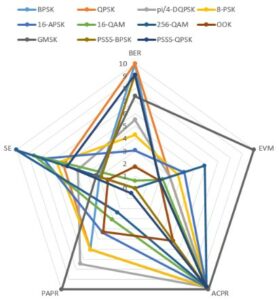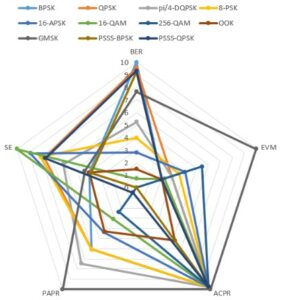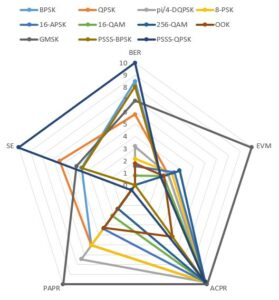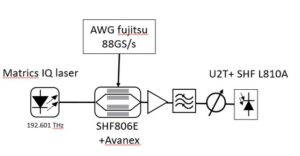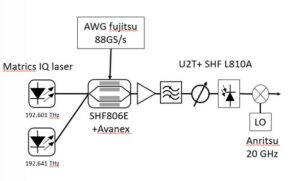The signal processing part (WP3) of WASSAP consists in:
- Selecting a well-suited waveform for sub-THz communications, based on its robustness to sub-THz impairments (phase noise, non-linearities, I/Q mismatch),
- Studying the synchronization at the receiver (frequency, timing and phase),
- Forward Error Coding (FEC).
As of now, FEC has not been studied. It will be investigated once the other parameters (waveform, carrier frequency, bandwidth) have been chosen.
Multiple waveforms have been studied, from linear Phase-and-Amplitude Modulations (PAM) to non-linear Continuous Phase Modulations (CPM). These waveforms have been compated with each other, bearing in mind the phase noise as a main impairment. This study lead to 2 publications [1-2]. The main results of this study are shown in the figure below:
Fig. 1 Left: Comparison without phase noise. Center: Comparison with medium phase noise. Right: Comparison with strong phase noise.
Three “good candidates” have been studied with the help of Institut Foton:
- GMSK (Gaussian Minimum Shift Keying), which will be cast out later in favor of the Raised Cosine (RC) CPM,
- FSIM (Filter Shapes Index Modulation): a PAM modulation with the addition of virtual bits, see Saad’s work [3] for further details.
- The spiral modulation [4], still at the simulation level. It is a PAM modulation that has the shape of a spiral, with one or more branches, depending on a parameter to optimize. This waveform is theoretically robust to phase noise. Once this waveform has been completely understood, experiments will be done to compare it to the other candidates.
Some experiments have been also conducted during the last six months, with the team from Institut Foton at ENSSAT (Lannion). An experimental campaign of three days was carried out at their lab in June 2021. Up to now, only three different systems have been used to test the waveforms in a wired, controlled lab scenario:
Electrical transmission (coaxial cable), with intermediate frequency at 10 GHz,
Optical transmission, intermediate frequency at 10 GHz and optical up-conversion at the laser frequency (192.601 THz),
Bi-laser optical transmission, with intermediate frequency at 10 GHz and optical up-conversion at 40 GHz.
The first two systems (electrical and optical) have one purpose: training. The last system is the one usually used in the sub-THz context, and its purpose is to train at relatively low frequency (40 GHz) before going up in frequencies. The last experiments were done on 19/11/2021. New experiments are on the way, with expected results in April/May.
- P. Desombre, H. Farès and Y. Louët, “Performance Comparison of Digital Modulations in the Presence of Gaussian Phase Noise in the Sub-THz Context,” 4th Int. Workshop Mobile THz Systems (IWMTS), Essen, Germany, Aug. 2021, pp. 1-5, doi: https://doi.org/10.1109/IWMTS51331.2021.9486786 .
- P. Desombre, H. Farès, and Y. Louët “Waveform comparison in the presence of Gaussian Phase Noise in the sub-THz context,” URSI-GASS, Aug 2021, Roma, Italy.
- M. Saad, J. Palicot, F. Bader, A. Chamas Al Ghouwayel, and H. Hijazi, “A novel index modulation dimension based on filter domain: Filter shapes index modulation,” IEEE Trans. Commun., pp 1–1, 2020.
- A. Ugolini, A. Piemontese, and T. Eriksson, “Spiral Constellations for Phase Noise Channels,” IEEE Trans. Commun., vol. 67, no. (11), pp. 7799–7810, Nov. 2019.

